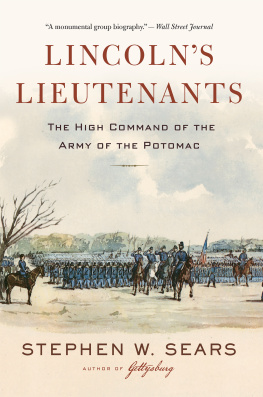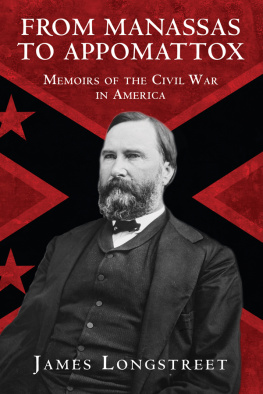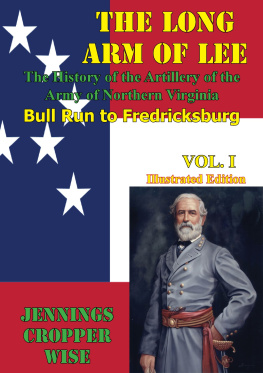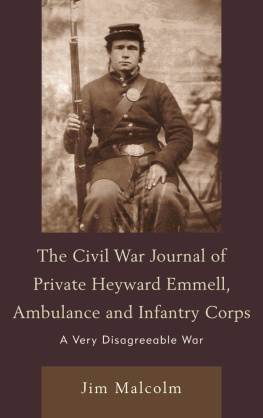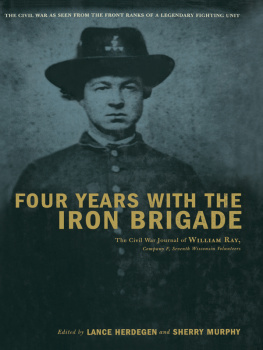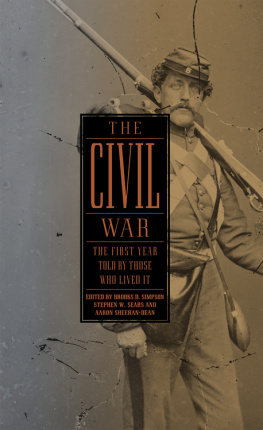Copyright 1993 by Stephen W. Sears
All rights reserved
For information about permission to reproduce selections from this book, write to or to Permissions, Houghton Mifflin Harcourt Publishing Company, 3 Park Avenue, 19th Floor, New York, New York 10016.
www.hmhco.com
The Library of Congress has cataloged the print edition as follows:
Haydon, Charles B., 18341864.
For country, cause & leader : the Civil War journal of Charles B. Haydon / edited by Stephen W. Sears.
p. cm.
Includes index.
ISBN 0-395-66360-1
1. Haydon, Charles B., 18341864Diaries. 2. United States. Army. Michigan Infantry Regiment, 2nd (18611865)Biography. 3. MichiganHistoryCivil War, 18611865Personal narratives. 4. MichiganHistoryCivil War, 18611865Regimental histories. 5. United StatesHistoryCivil War, 18611865Personal narratives. 6. United StatesHistoryCivil War, 18611865Regimental histories. 7. SoldiersMichiganDiaries. I. Sears, Stephen W. II. Title. III. Title: For country, cause, and leader.
E514.5 2nd.H38 1993
973.8'98dc20
[B] 92-46272 CIP
e ISBN 978-1-328-74482-1
v1.1016
, courtesy of Michigan Historical Collections, Bentley Historical Library
Introduction
T HE GOOD SOLDIER HAYDON: that was how he wanted to be remembered. He was loyal, trustworthy, obedient, brave, and certainly he was motivated. On July 4, 1862, in one of the darker hours of the war following the Federal retreat from Richmond, he could write without self-consciousness that he cheered most heartily for country, cause & leader. To Charles B. Haydon the Union meant as much as life itself, and by way of documenting his belief he kept one of the most striking of Civil War journals.
Charles Haydon was not the typical Civil War soldier. When he enlisted in the first rush to the colors in April 1861 he was twenty-seven, half a dozen years older than most of his fellow volunteers. He was also considerably better educated than most of them, with four years of college and a beginning law practice when he signed up. His favorite campfire reading was the Atlantic Monthly, the most intellectually challenging American magazine of the day. When in the field he went to some lengths to obtain a copy of Dickenss newly published Great Expectations. (In comparison to the authors earlier work, he thought, his best days are past.) He filled the long hours of boredom by recalling passages of poetry he had committed to memory, and he enlivened his journal-writing by quoting from the likes of Byron, Addison, Whittier, and William Cullen Bryant, hardly the usual fare of Civil War diarists.
While at first, like most of his fellows, Haydon expected little more than a three-month war, he sensed that this military experience promised to be a unique chapter in his life. He determined to make a full, careful, and analytical record of it; like a traveler embarking on the Grand Tour, he wanted by means of his journal to be able to relive the experience in later years. His effort at journalizing, as he called it, never faltered through nearly three years of soldiering. He did his journalizing in pocket-sized notebooks, and as each was filled he sent it home for safekeeping. In all he would fill twenty of these notebooks; a twenty-first has been lost, leaving the only gap in his record of service. Because of the care he took in this regard, it may be supposed he intended someday to write a memoir of his experiences in this great American Civil War.
It may also be supposed that had that memoir been written, it would have depicted history with the bark on, for Charles Haydons is one of the most candid, unblinking Civil War journals on record. He had not been in the army a week when he remarked that if the men would only pursue the enemy as vigorously as they do the whores they will make very efficient soldiers. The men pursue liquor in these pages with the same single-mindedness, and they plunder everything not nailed down, and often enough even that did not stop them. The war as Haydon describes it is not a picture-book war.
Born in 1834 in Vermont, Charles B. Haydon was raised in the new (1837) state of Michigan, in the old Northwest Territory. His home was Decatur, a village in the southwestern corner of the state twenty-five miles from Kalamazoo. In 1857 he completed four years study at the University of Michigan. Electing to enter the legal profession, he read law in a firm in Kalamazoo, where by his account he was earning five dollars a week as a law clerk when war broke out. God only knows how much I loved the Law & how hard it was to give it up, he wrote. He had one sibling, his younger brother Arthur. His mother was dead. His father, Philotas Haydon, had recently taken a second wife, a young woman of Charless generation, and started a second family. Although Charles was unmarried, he was interested enough in a woman he calls only Mary R. at least to give thought to a wartime marriage.
On April 22, 1861, one week after President Lincoln called on the Northern states for militia to suppress combinations too powerful to be suppressed by the ordinary course of judicial proceedings, Charles Haydon enlisted in a local militia company, the Kalamazoo Light Guard. While later he expressed regret that he had not joined the Light Guard at an earlier day so as to be better trained for wartime service, his maturity and standing in the community were enough to see him appointed 3rd sergeant of the company.
Haydon did not agonize over his decision to enlist. To him it was simply his patriotic duty. The Secessionists, as he termed the enemy, must not be allowed to destroy the Union. When the Kalamazoo Light Guard was subsequently told it would be required to serve not three months in state service but three years in federal service, Haydon did pause. Three years, he was sure, would mean for him the loss of his chosen career in the law. The hesitation was brief, soon overcome by the pull of duty. On May 25 he gave his oath of service to the United States. He was bound to the army for three years.
By then the Kalamazoo Light Guard was officially Company I, 2nd Michigan Infantry, and training in Detroit. Haydon quickly became inflexibly conscientious about his sergeants duties. On the fourth day of keeping his journal he recorded that the 2nd Michigans colonel, Israel B. Richardson, had sharply berated him for not knowing his job. After Richardsons censure he swore, I shall not be caught again on that point, and he never was. Acquiring a copy of Hardees Tactics, he studied the drills until he knew them forward and backward. Charles Haydons military education was to be largely the result of his own efforts but it was no less thorough and complete for that.
The Civil War statistician William F. Fox included the 2nd Michigan Infantry in his list of 300 Union fighting regiments, and with good reason. Of the more than 2,000 regiments in the Northern armies, just 20 suffered more battle dead than the 2nd Michigan. Of the men who enlisted originally in the 2nd, plus those who joined later as replacements, 21.5 percent died in battle or of disease; the regiments total wartime losswounded, missing, dead from all causescame to 55 percent. At times, as Haydon notes, this attrition reduced the regiment to a shadow. In its fight at Jackson, Mississippi, in 1863, for example, in which Haydon was severely wounded, he records that his company, with an on-paper strength of 101 men, brought but 20 to the battle line.
In 1861 Michigan was the first western state to send troops to the eastern theater in any numbers, and the 2nd Michigan arrived in Washington less than two months after Mr. Lincolns call. It participated in skirmishing engagements at First Bull Run and then went into eight months training with General McClellans Army of the Potomac. During 1862 it was in McClellans Peninsula campaign against Richmond from first to last, then with Pope at Second Bull Run and, after missing the Antietam campaign, with Burnside at Fredericksburg. Assigned now to the peripatetic Ninth Corps, the 2nd Michigan went west in February 1863 for service in Kentucky and in Grants campaign against Vicksburg. Haydon was wounded in Mississippi on July 11, shortly after Vicksburgs surrender, and while he recuperated his regiment defended against the Confederate besiegers of Knoxville.
Next page





